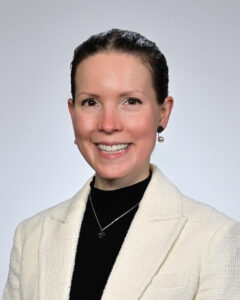Authors: Meghan Etsey, Rhea Manohar, MPH; Leah Liszak, Mallory Johnson, Dr. Ariela Marshall on behalf of the Gender Equity Task Force
Women have always been at the heart of medicine– caring, leading, innovating, and reshaping the future of healthcare. Yet, our experiences often reveal a different reality: persistent gaps in pay, promotion, representation, and recognition. These truths aren’t just statistics; they’re reflections of the barriers women physicians, trainees, and patients face every day, alongside the contributions we continue to make despite them.
This collection of “We…” statements highlight both our challenges and our strengths. Each fact is a piece of a larger story—one that demands visibility, accountability, and change. Together, they serve as a reminder that progress in medicine is inseparable from progress toward equity.
Medical Students and Residents
We are half of medical students, yet remain underrepresented in leadership roles across academic medicine (AAMC, 2022).
We make up 81% of OB/GYN residents, 54% of faculty, but only 20% of department chairs (Hofler et al., 2015).
We pursue subspecialty fellowships at lower rates than our male colleagues (Woodyard et al., 2023).
Practicing Physicians
We represent only 36% of practicing physicians in the U.S., despite making up half of medical school entrants (AAMC, 2022).
We are twice as likely to be addressed by our first names, compared to our male colleagues (Harvey et al., 2022).
We are less likely to receive referrals, with male surgeons receiving the majority—79.3% from female physicians and 87.1% from male physicians (Dossa et al., 2021).
Surgical Training
We have to adjust our bodies to use tools designed for larger male physiques, leading to straining and improper technique (Morse et al., 2023).
We are less likely to pursue surgical careers, with women making up just 22.6% of general surgeons, 18% in plastic surgery, 15% in vascular surgery, and 10% in neurosurgery (Winter, 2025).
Microaggressions and Feedback
We experience microaggressions regularly in training, such as being accused of being angry when we speak calmly (Myers et al., 2023).
We receive feedback that focuses on interpersonal manners, while men receive feedback emphasizing technical skill (Madanay, 2025).
We are more likely to face gender harassment, with one in three female medical students reporting experiencing this (Boyle, 2024).
Burnout and Mental Health
We face higher stress and burnout rates in residency, with women reporting greater challenges achieving work-life balance (Karakcheyeva, 2024).
We are 71% more likely to die by suicide, compared to male physicians, reflecting structural and cultural stressors (Zimmermann et al., 2024).
Leadership and Career Development
We make up only 27% of medical school deans, compared to our male counterparts (AAMC, 2025).
We hold only 18% of department chair positions across all specialties, despite representing nearly half of the physician workforce (AAMC, 2022).
We are more likely to leave academic medicine mid-career, citing lack of mentorship and advancement opportunities (Chen et al., 2023).
Pay
We earn 26% less than male physicians, a gap that persists even after adjusting for specialty and hours worked (Doximity, 2025).
We lose nearly $2 million, over the course of a 40-year career because of the gender pay gap in medicine (Doximity, 2025).
Research
We receive less research funding, with women scientists awarded smaller NIH grants on average compared to men (Lyubarova et al., 2023).
We are underrepresented on editorial boards of major medical journals, reinforcing inequities in scholarship (Lin et al., 2021).
Speaking Engagements and Awards
We are less likely to be invited as keynote speakers at major medical conferences, perpetuating the visibility gap (Krasnoff et al., 2025).
We are less likely to receive major awards in medicine and science, even when contributions are comparable to men’s, with some exceptions in advocacy-based awards (Fang et al., 2021).
Caregiving Responsibilities
We balance work and caregiving responsibilities disproportionately, contributing to higher burnout rates (Sullivan et al., 2023).
We face a “motherhood penalty,” where physician mothers are viewed as less committed, affecting evaluations and promotions (Sullivan et al., 2023).
Device Testing and Trials
We remain excluded from medical device design and testing, making “neutral” equipment that often fits men, not women (Phillips et al., 2022).
We were historically excluded from clinical trials, creating knowledge gaps in how treatments affect women (Bierer et al., 2022).
Patients
We, as patients, experience bias, such as women receiving delayed pain treatment and slower cardiac care in emergency settings (Greenwood et al., 2018).
… But also
We deliver care that results in better outcomes for some patients, including lower mortality and readmission rates for Medicare patients (Harris, 2024).
We provide more patient-centered communication, spending more time with patients and engaging in shared decision-making (Jackson et al., 2020).
We deliver safer surgical outcomes in some contexts, with lower complication rates compared to male surgeons (Wallis et al., 2023).
We make up more than one half of all medical students in the United States, since 2018 we’ve outnumbered male MD students and DO students since 2004 (Menzes et al., 2025)
These “We…” statements are not just words on a page, they are lived truths. They reflect the realities women navigate, the inequities confronted, and the resilience brought to every corner of medicine. They remind us that women in healthcare are not only bearing the weight of systemic barriers but also driving the solutions forward. To honor these truths is to acknowledge both the unfinished work and the undeniable strength of women in medicine. And to act on them is to move us all closer to the equity that healthcare deserves.
References
- Association of American Medical Colleges. (2022). The state of women in academic medicine: Exploring pathways to equity. AAMC.
- Association of American Medical Colleges. U.S. medical school deans by dean type and gender. AAMC. January 2025. Accessed September 9, 2025. https://www.aamc.org/data-reports/faculty-institutions/data/us-medical-school-deans-trends-type-and-gender
- Bierer, B. E., Meloney, L. G., Ahmed, H. R., & White, S. A. (2022). Advancing the inclusion of underrepresented women in clinical research. Cell reports. Medicine, 3(4), 100553. https://doi.org/10.1016/j.xcrm.2022.100553
- Boyle P. Women in medicine make gains, but obstacles remain. AAMCNews. July 9, 2024. Accessed September 09, 2025. https://www.aamc.org/news/women-medicine-make-gains-obstacles-remain
- Carr, P. L., Raj, A., Kaplan, S. E., Terrin, N., Breeze, J. L., & Freund, K. M. (2018). Gender differences in academic medicine: Retention, rank, and leadership comparisons from the national faculty survey. Academic Medicine, 93(11), 1694–1699. https://doi.org/10.1097/ACM.0000000000002146
- Chen YW, Orlas C, Kim T, Chang DC, Kelleher CM. Workforce Attrition Among Male and Female Physicians Working in US Academic Hospitals, 2014-2019. JAMA Netw Open. 2023;6(7):e2323872. Published 2023 Jul 3. doi:10.1001/jamanetworkopen.2023.23872
- Dossa F, Zeltzer D, Sutradhar R, Simpson AN, Baxter NN. Sex Differences in the Pattern of Patient Referrals to Male and Female Surgeons. JAMA Surg. 2022;157(2):95-103. doi:10.1001/jamasurg.2021.5784
- Doximity, Inc. 2025 Physician Compensation Report. Press release. July 31, 2025. Accessed September 9, 2025.
- Fang, A. C., Chekijian, S. A., Zeidan, A. J., Choo, E. K., & Sethuraman, K. N. (2021, November). National Awards and Female Emergency Physicians in the United States: Is the “Recognition Gap” Closing? The Journal of Emergency Medicine. https://www.sciencedirect.com/science/article/pii/S0736467921005473
- Greenwood, B. N., Carnahan, S., & Huang, L. (2018). Patient–physician gender concordance and increased mortality among female heart attack patients. Proceedings of the National Academy of Sciences, 115(34), 8569–8574. https://doi.org/10.1073/pnas.1800097115
- Harvey JA, Butterfield RJ, Ochoa SA, Yang YW. Patient Use of Physicians’ First (Given) Name in Direct Patient Electronic Messaging. JAMA Netw Open. 2022;5(10):e2234880. doi:10.1001/jamanetworkopen.2022.34880
- Harris, E. (2024, May 17). Patients treated by female physicians had better mortality rates. JAMA. https://jamanetwork.com/journals/jama/article-abstract/2819073
- Holman, L., Stuart-Fox, D., & Hauser, C. E. (2018). The gender gap in science: How long until women are equally represented? PLoS Biology, 16(4), e2004956. https://doi.org/10.1371/journal.pbio.2004956
- Jackson, J. L., Farkas, A., & Scholcoff, C. (2020). Does Provider Gender Affect the Quality of Primary Care?. Journal of general internal medicine, 35(7), 2094–2098. https://doi.org/10.1007/s11606-020-05796-0
- Karakcheyeva V, Willis‑Johnson H, Corr PG, Frame LA. The well-being of women in healthcare professions: a comprehensive review. Glob Adv Integr Med Health. 2024;13:27536130241232929. doi:10.1177/27536130241232929
- Krasnoff, C. C., Ferrin, P. C., Moeller, E. A., & Hathaway, B. A. (2025). Decade-Long Examination of Gender Disparities in Session and Speaker Roles at Hand Surgery Conferences. Hand (New York, N.Y.), 15589447251324664. Advance online publication. https://doi.org/10.1177/15589447251324664
- Lin, J. S., Weber, K. L., & Samora, J. B. (2021). How Does Representation of Women on Editorial Boards Compare Among Orthopaedic, General Surgery, and Internal Medicine Journals?. Clinical orthopaedics and related research, 479(9), 1939–1946. https://doi.org/10.1097/CORR.0000000000001735
- Ly, D. P., Jena, A. B., & Frank, R. G. (2021). Gender disparities in time spent on household activities by physicians. JAMA Internal Medicine, 181(9), 1203–1205. https://doi.org/10.1001/jamainternmed.2021.2703
- Lyubarova, R., Salman, L., & Rittenberg, E. (2023). Gender Differences in Physician Burnout: Driving Factors and Potential Solutions. The Permanente journal, 27(2), 130–136. https://doi.org/10.7812/TPP/23.023
- Madanay F, Bundorf MK, Ubel PA. Physician Gender and Patient Perceptions of Interpersonal and Technical Skills in Online Reviews. JAMA Netw Open. 2025;8(2):e2460018. doi:10.1001/jamanetworkopen.2024.60018
- Menezes, S. B., Shenton, A. N., Hays, A. G., & Taub, C. C. (2025). Trends of Representation of Women in Professional Medical Societal Leadership in the United States and Europe. JACC. Advances, 4(2), 101522. https://doi.org/10.1016/j.jacadv.2024.101522
- Morse E, Harpel L, Born H, Rameau A. Female Surgical Ergonomics in Otolaryngology: A Qualitative Study. Laryngoscope. 2023;133(11):3034-3041. doi:10.1002/lary.30711
- Myers AK, Williams MS, Pekmezaris R. Intersectionality and Its Impact on Microaggression in Female Physicians in Academic Medicine: A Cross-Sectional Study. Womens Health Rep (New Rochelle). 2023;4(1):298-304. Published 2023 Jun 26. doi:10.1089/whr.2022.0101
- Oliveira, D. F., Ma, Y., Woodruff, T. K., & Uzzi, B. (2019). Comparison of National Institutes of Health grant amounts to first-time male and female principal investigators. JAMA, 321(9), 898–900. https://doi.org/10.1001/jama.2019.0051
- Patterson, J., Bloom, J., Reddy, S., & Kiefer, J. (2022). Parental leave policies and physician wellness: A critical review. Academic Medicine, 97(4), 483–490. https://doi.org/10.1097/ACM.0000000000004360
- Phillips, S. P., Gee, K., & Wells, L. (2022). Medical Devices, Invisible Women, Harmful Consequences. International journal of environmental research and public health, 19(21), 14524. https://doi.org/10.3390/ijerph192114524
- Robert Wood Johnson Medicine Magazine. Women in Surgery: Increasing in Numbers—and Influence. Winter 2025. Robert Wood Johnson Medical School (Rutgers). Accessed September 07, 2025. https://rwjms.rutgers.edu/magazine/winter-2025/women-surgery-increasing-numbers-influence
- Shen MR, Tzioumis E, Andersen E, et al. Impact of Mentoring on Academic Career Success for Women in Medicine: A Systematic Review. Acad Med. 2022;97(3):444-458. doi:10.1097/ACM.0000000000004563
- Sullivan, A. B., Hersh, C. M., Rensel, M., & Benzil, D. (2023). Leadership inequity, burnout, and lower engagement of women in medicine. Journal of Health Service Psychology, 49, 33–39. https://doi.org/10.1007/s42843-023-00078-9
- Wallis, C. J. D., Jerath, A., Aminoltejari, K., Kaneshwaran, K., Salles, A., Coburn, N., Wright, F. C., Gotlib Conn, L., Klaassen, Z., Luckenbaugh, A. N., Ranganathan, S., Riveros, C., McCartney, C., Armstrong, K., Bass, B., Detsky, A. S., & Satkunasivam, R. (2023). Surgeon Sex and Long-Term Postoperative Outcomes Among Patients Undergoing Common Surgeries. JAMA surgery, 158(11), 1185–1194. https://doi.org/10.1001/jamasurg.2023.3744
- Woodyard KC, Lee E, Ferguson R, et al. Surgical fellowships demonstrate variable improvement in gender representation despite greater female enrollment in general surgery residencies. J Surg Educ. 2023;80(8):1104–1112. doi:10.1016/j.jsurg.2023.05.004
- Ying Y, Dupre J, Bhanji F. Female surgical trainee recruitment and attrition – a 10‑year national retrospective review. Am J Surg. 2023;225(2):282–286. doi:10.1016/j.amjsurg.2022.07.020
- Zimmermann C, Strohmaier S, Herkner H, Niederkrotenthaler T, Schernhammer E. Suicide rates among physicians compared with the general population in studies from 20 countries: gender‑stratified systematic review and meta‑analysis. BMJ. 2024;386:e078964. doi:10.1136/bmj-2023-078964
About the Authors
Meghan Etsey is a fourth year medical student from St. George’s University. She has a Bachelors of Arts in Biology and a Bachelors of Arts in Nutrition and Dietetics from Bluffton University in Bluffton, Ohio. She served as the President of the St. George’s University’s Women in Medicine chapter in St. George, Grenada where she expanded relationships with the community and worked towards educating women and helping the youth. She is also a member of the Gender Equity Task Force and Sex and Gender Health Collaborative Committees within the American Medical Women’s Association. When she is not pursuing medicine, you can find her with her friends and family on different road trips and adventures exploring the world.
Rhea Manohar is a third year medical student from St. George’s University. She has a Masters in Public Health with a concentration in Maternal and Child Health from George Washington University Milken Institute of Public Health and a Bachelors of Science in Microbiology, Immunology, and Public Health from the University of Miami. She served as Co-VP of OB/GYN Education for St. George’s University’s Women in Medicine chapter in St. George, Grenada where she developed and implemented hands-on workshops to further reproductive health issues and bolstered medical students abilities to navigate physician-patient communication. Prior to medical school, she was a Research Associate for Fors Marsh Group, where she led qualitative and quantitative public health research and campaign development for federal agencies (e.g., CDC, NIH, DHHS, CPSC). She is also a member of the Gender Equity Task Force and Reproductive Health Coalition within the American Medical Women’s Association. When she is not pursuing medicine, you can find her reading, exploring artistic passions, and spending time connecting with friends and family.
Leah Liszak is a third year medical student from St. George’s University. She has a Bachelors of Science in Biomedical Science from Oakland University in Auburn Hills, Michigan. She served as the SMILEs Orphanage Home Coordinator of the St. George’s University Humanism Service Organization in St. George, Grenada where she fostered impactful relationships with at-risk female youth and developed seminars to educate, encourage, and engage their personal growth. She is also a member of the Gender Equity Task Force with the American Medical Women’s Association. When she is not pursuing medicine, you can find her enjoying time with friends and family, working towards athletic pursuits in the gym, and testing new pastry recipes.
Mallory Johnson is a fourth-year medical student from St. George’s University. She holds a Bachelor of Science in Forensic Science and a Bachelor of Science in Chemistry from Tiffin University. She worked as an Analytical Chemist at P&G and KAO before medical school. She is passionate about giving back to vulnerable communities and providing equal access and opportunity to medical care. She is a member of the Domestic Violence and Music in Medicine Committees within the American Medical Women’s Association. When she’s not doing schoolwork, you can find her playing her cello, reading cozy mysteries, and playing with her poodles, Gertie and Maple.
Dr. Ariela Marshall is a Harvard-trained physician and an internationally renowned advocate, career development advisor, and mentor. Dr. Marshall specializes in bleeding and clotting disorders, especially as they relate to women’s health. She has worked at Mayo Clinic and the University of Pennsylvania and currently practices part-time as a consultative hematologist at the University of Minnesota. In addition to her clinical work, Dr. Marshall is a highly respected leader, mentor, and speaker. She is an active leader with the American Society of Hematology (where she led efforts to found the Women in Hematology Working Group and currently holds seats on the Women in Heme Working Group, Committee on Communications and Media Experts Subcommittee) and American Medical Women’s Association (leading the Infertility Working Group and holding seats on the Gender Equity Task Force). She is the Chief Innovation Officer at Women in Medicine and the Curriculum Chair at IGNITEMed, which are both 501(c)(3) nonprofit organizations dedicated to promoting career development for women in medicine. She speaks regularly on a national and international scope to discuss her efforts to advance career development and mentorship for physicians, gender equity, fertility/infertility awareness, parental health and wellbeing, reproductive health and rights, and work-life integration.





